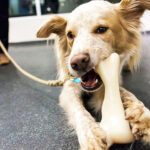Keeping our furry friends clean is an essential part of responsible pet ownership, but how often should we actually be giving our dogs a bath? The answer isn’t as straightforward as it might seem, as various factors can influence the ideal bathing schedule for your pup. From breed type and coat condition to lifestyle and seasonal changes, each dog has unique needs when it comes to hygiene.
In this article, we’ll explore the best practices for bathing your dog, providing you with expert tips and insights to ensure a happy, clean pup. Whether you’re dealing with a muddy outdoor adventurer or a pampered pooch, understanding the right frequency for baths can help maintain your dog’s health, comfort, and overall happiness. Let’s dive into the world of canine cleanliness and discover how to keep your four-legged friend looking and feeling their best!
Table of Contents
- Understanding Your Dogs Coat Type and Bathing Needs
- Signs Your Dog Might Need a Bath Sooner Than You Think
- Choosing the Right Shampoo and Bathing Techniques
- Establishing a Bathing Routine for Your Pups Happiness and Health
- Q&A
- In Conclusion
Understanding Your Dogs Coat Type and Bathing Needs
Understanding your dog’s coat type is crucial for determining the right bathing frequency to keep them happy and clean. Different dogs have varying coat types that not only affect their appearance but also influence how often they need a bath. For instance, short-haired breeds like Beagles or Boxers may only require a bath every few months, as their fur naturally sheds dirt and oils. In contrast, long-haired breeds like Golden Retrievers or Shih Tzus often need more frequent bathing to prevent matting and skin issues. Consider your dog’s lifestyle as well; if they spend a lot of time outdoors or enjoy rolling in the mud, they might need more frequent baths, regardless of their coat length.
Another important aspect to consider is the dog’s skin sensitivity and any specific grooming requirements they may have. Some breeds, such as the Bichon Frise or Maltese, benefit from regular grooming sessions to maintain their coat’s health and prevent tangles. It’s also good to take note of any signs indicating your dog may need a bath, such as odors, excessive itching, or visible dirt. Here’s a quick reference table to help you identify bathing needs based on coat type:
| Coat Type | Bathing Frequency |
|---|---|
| Short Hair | Every 2-3 months |
| Medium Hair | Every 1-2 months |
| Long Hair | Every 2-4 weeks |
| Curly Hair | Every 4-6 weeks |
Signs Your Dog Might Need a Bath Sooner Than You Think
Keeping your furry friend clean and comfortable is essential, but sometimes it’s easy to underestimate when they might need a bath. Watch for signs that indicate your dog may require an earlier wash, ensuring they stay happy and free from unnecessary discomfort. Unpleasant odor is a significant indicator; if your pup starts to smell less than fresh, it might be time for a scrub. Additionally, keep an eye out for visible dirt or mud on their coat, especially after outdoor playdates or trips to the park. These signs not only reveal the need for a bath but can also prevent skin issues that arise from trapped dirt and debris.
Another clue your dog may need a bath sooner includes excessive scratching or biting at their fur, which could indicate that their coat is collecting allergens or irritants. If you notice your dog has developed greasiness in their fur, particularly in breeds with oilier coats, it’s a strong signal that a thorough cleaning is in order. Lastly, if your dog experiences changes in behavior, such as being less playful or more lethargic, it may be related to discomfort from their unclean coat. Regular observation can help you determine the perfect bathing schedule tailored to your pup’s needs.
Choosing the Right Shampoo and Bathing Techniques
Finding the right shampoo for your dog is crucial for maintaining their skin and coat health. Consider your dog’s specific needs—for example, if they have sensitive skin, look for hypoallergenic formulas that are free from harsh chemicals. If your pup has a specific coat type, such as curly or wiry, choose a shampoo designed to enhance and maintain that texture. It’s also wise to select a product that contains natural ingredients, as they are gentler and have less chance of causing irritation. Before you lather up, always conduct a patch test to ensure there are no adverse reactions.
In addition to the right shampoo, the bathing technique itself plays a vital role in the overall experience for your dog. Follow these helpful tips for an effective bath time:
- Brush your dog before bathing to remove loose fur and tangles.
- Use lukewarm water for comfort—never hot or cold.
- Wet your dog gradually to prevent them from getting startled.
- Apply shampoo starting from the neck down, avoiding the eyes and ears.
- Rinse thoroughly to prevent residue build-up, which can irritate the skin.
Here’s a simple table summarizing common shampoo types and their benefits:
| Shampoo Type | Best For |
|---|---|
| Hypoallergenic | Sensitive skin |
| Moisturizing | Dry skin |
| Flea & Tick | Parasite prevention |
| Deodorizing | Odor control |
| Shine Enhancer | Coat luster |
Establishing a Bathing Routine for Your Pups Happiness and Health
Creating a consistent bathing routine is crucial for your dog’s overall well-being and happiness. Regular baths not only keep your pup feeling fresh but also help eliminate dirt, allergens, and unwanted odors. Consider the following tips for establishing an appropriate bathing schedule:
Know Your Breed: Some breeds require more frequent bathing due to their coat types. For instance, long-haired breeds may need baths every 4-6 weeks, while short-haired breeds can often go longer.
Assess Activity Level: If your dog is particularly active or enjoys outdoor adventures, you may need to bathe them more often to keep their skin and coat healthy.
Check Skin Condition: Always monitor your dog’s skin for signs of irritation or excessive oiliness, which may indicate the need for more frequent baths.
To help you determine the right bathing frequency, consider the following simple table indicating general guidelines:
| Dog Type | Bathing Frequency |
|---|---|
| Short-Haired Breeds | Every 6-8 weeks |
| Long-Haired Breeds | Every 4-6 weeks |
| Active Dogs | As needed (1-2 times a month) |
| Puppies | Every 1-3 months (based on need) |
By understanding your pup’s specific needs and adjusting their bathing routine accordingly, you can ensure they remain healthy and happy. Don’t forget to use dog-friendly shampoos and conditioners to maintain their coat’s natural oils and avoid irritation.
Q&A
Q&A: How Often Should You Give Your Dog a Bath? Tips for a Happy, Clean Pup
Q1: How often should I give my dog a bath?
A1: The frequency of bathing your dog largely depends on their breed, coat type, and lifestyle. Generally, most dogs benefit from a bath every 1 to 3 months. However, if your dog enjoys outdoor adventures or has a tendency to get dirty, you might need to bathe them more often. Always consult your veterinarian or a professional groomer for personalized advice.
Q2: Are there specific breeds that require more frequent baths?
A2: Yes! Breeds with long or thick fur, like Golden Retrievers or Bichon Frises, may require more frequent grooming and bathing due to their propensity to trap dirt and debris. On the other hand, short-haired breeds, like Beagles or Boxers, may require fewer baths but still benefit from regular brushing.
Q3: What signs indicate that my dog needs a bath?
A3: If your dog starts to develop an unpleasant odor, appears visibly dirty, or has excessive shedding, it’s likely time for a bath. Additionally, if you notice they have collected allergens or have rolled in something unsavory, it’s a good idea to schedule a wash.
Q4: Can I use human shampoo for my dog?
A4: It’s best to avoid using human shampoo on dogs, as they have different skin pH levels. Instead, opt for a shampoo specifically formulated for dogs. These products will cleanse their coat effectively without irritating their skin.
Q5: What are some tips for making bath time enjoyable for my dog?
A5: To make bath time a positive experience, try the following:
- Create a calm environment: Choose a quiet time and place.
- Use warm water: Ensure the water temperature is comfortable.
- Incorporate treats: Offer treats and praise during the bath to create positive associations.
- Introduce a non-slip mat: This can help your pup feel secure in the tub.
- Be gentle: Use a soft spray and avoid getting water in their ears and eyes.
Q6: What if my dog hates baths?
A6: If your dog is particularly averse to baths, consider alternative cleaning methods, such as dry shampoos or wipes designed for dogs. Gradually introduce them to bath time by letting them play around the bath area without water first. Always focus on positive reinforcement to help ease their anxiety.
Q7: Is it necessary to bathe my dog during the winter months?
A7: While your dog may not get as dirty in the winter, it’s still important to maintain their hygiene. If they are frequently exposed to salt, mud, or snow, occasional baths may still be necessary. Just be sure to dry them gently afterward to keep them warm.
Q8: Are there any health considerations to keep in mind?
A8: Yes! Over-bathing can lead to dry skin, so it’s important to strike a balance. If your dog has skin issues or allergies, consult your veterinarian for a bathing schedule tailored to their specific needs. They may recommend specialized shampoos or treatments.
Q9: How can I maintain my dog’s cleanliness between baths?
A9: Regular brushing can help reduce shedding and dirt buildup, keeping your dog cleaner for longer. Additionally, consider paw cleaning after walks and using dog-friendly wipes for quick cleanups. Maintaining their dental hygiene and checking their ears and nails will also contribute to overall cleanliness.
By following these guidelines and considering your dog’s unique needs, you can ensure they stay happy and healthy while enjoying their bath time!
In Conclusion
keeping your furry friend clean and happy doesn’t have to be a daunting task. By understanding your dog’s unique needs and following the tips outlined in this article, you can establish a bathing routine that suits both you and your pup. Remember, the frequency of baths can vary depending on factors like your dog’s breed, coat type, and lifestyle. Whether it’s a weekly spa day or an occasional rinse, the key is to ensure that bath time is a positive experience filled with love and care.
So gather your supplies, create a comfortable bathing environment, and enjoy those special moments with your four-legged companion. After all, a clean dog is not only a happy dog but also a healthy one! Now go forth and keep that wagging tail shining bright!
















